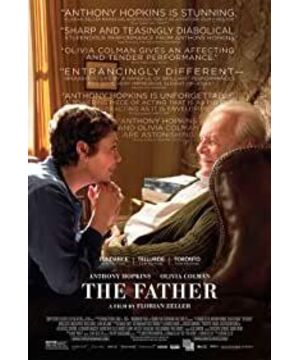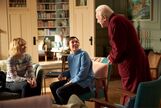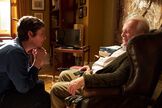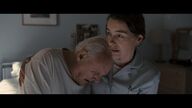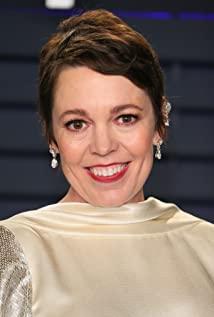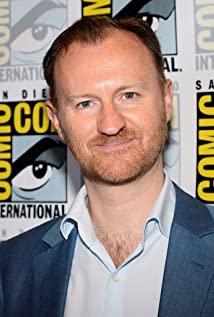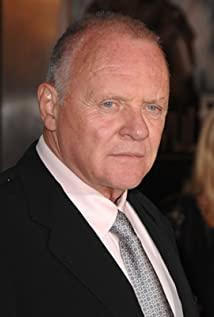"Father Trapped in Time" is not a suspenseful film, but there are many hidden clues worth paying attention to. This movie reminds me to some extent of "Life and Death", both of which construct an illusion through the perspective of the protagonist, and then click to break the illusion to let the truth surface. Both films use unreliable narrators—the dying person/patient with Alzheimer’s disease who gradually loses consciousness. The stories I have seen are convinced; however, all illusions are bound to have flaws and will be invaded by the truth, so the careful audience can be fooled by the clues.
The most important clue in this film is the change in the "apartment" where my father lives.
In the film, the father actually lived in three apartments:
1) Father’s own apartment 2) Daughter’s apartment 3) Nursing home
Film images show apartment also has three:
1) Warm-toned apartment 2) Cool-toned apartment 3) Blue nursing home
At first glance, the whole movie starts with the father in the warm-colored apartment and ends in the nursing home room, as if it were narrated in a positive order. But in fact the opposite is true. The film may be regarded as a two-line narrative, one line is the positive sequence-the daughter's perspective, narrating the process of Anna's inability to continue to take care of her father as her father's illness gradually deteriorated and her consciousness became more and more blurred, and finally decided to send her father to a nursing home. . The other line is the reverse order-the father's perspective, which describes the memories and hallucinations of a father who has already suffered from severe Alzheimer's disease in a nursing home. The narrative of this line is very chaotic and ethereal, and there are often dislocations of space and characters. The most obvious one is the magical reflection of the two apartments in warm and cool colors shown in the first 80% of the film.
Not much nonsense, directly above the picture:
It can be seen from the three sets of pictures that the two spaces of warm and cold tones are closely mirrored in the layout and furnishings. How to explain this phenomenon? Could it be that the daughter repainted the apartment after taking the father over? Or is the layout and decoration of the two apartments of the daughter and father almost identical? This is obviously unlikely. So we have enough reason to suspect that the two spaces presented to us by the movie are distorted images in the protagonist's brain, not the real environment.
In fact, only the images of the nursing home are real and reliable, and the father’s apartment/daughter’s apartment that appeared earlier was pieced together by the father based on the scene of the nursing home and his own memory.
At the end of the film, my father is so confused that he can’t remember who he is. In this case, he can only rely on the sights and fragmented memories to build an understandable “familiar environment” to explain where he is. Get a sense of security in this way. So we can see that the apartment in his mind has the layout of a nursing home and his daughter's paintings at the same time. This space is actually a reorganization of memory and present, illusion and reality.
(It’s not difficult to understand why the French son-in-law in the eyes of my father sometimes appears as a male hospital nurse. My father’s memory is fading away, and he has begun to lose track of what the French son-in-law looks like he has not seen in months. So, just as he made up his own apartment according to the environment of the nursing home, he also made up the obscure son-in-law in his memory according to the image of young men he most often sees at present, the caregiver. He also once could not distinguish between female nurses. And daughter.)
But as mentioned above, the illusion will always show its feet. It's like being in a dream. When you find a tiny unreasonable place in it, all the lifelike dreams collapse in an instant. In this movie, although the father's consciousness continues to degenerate, the scenes seen by the sober audience gradually appear bugs, so that they are getting closer and closer to the truth, and finally become one with reality. For example, the warm-colored apartment at the beginning of the opening turned into a blue similar to the decoration of the nursing home at 23 minutes, the father's clothing changed from formal wear to the pajamas of the nursing home, the painting of the little daughter disappeared from the wall, and the plastic chairs in the corridor of the nursing home appeared in the daughter's home. At the end of the corridor, the room that was supposed to be the study room opened the door and turned out to be a utility room...
Space distortion is an old stalk of horror movies. This movie reveals a cruel truth to us through Anthony's eyes: old people suffering from Alzheimer's disease may always face this fear of constant changes in the surrounding space.
On the one hand, "Father" disrupts the narrative, combines the fictitious and the actual, deliberately creates a perplexed and uneasy perception, so that the audience can experience the mental state of the elderly with Alzheimer's disease; on the other hand, it gives enough clues and hints to make the whole story structure. Strict and orderly, it will not become a running account diary for the delirium. Anthony Hopkins gave a great performance that is not inferior to any actor in film history. There will not be a second in the whole process to remind you that he used to be a cannibal (bushi). Olivia Coleman also created a character that is hundreds of times better than Queen Lara in "The Beloved". The all-white lineup may be difficult to get the awards it deserves in Hollywood today, but it will definitely leave its name in the acting textbook. The same is true for this film. I always believe that "touching people's hearts" is the real vitality of the film.
View more about The Father reviews


